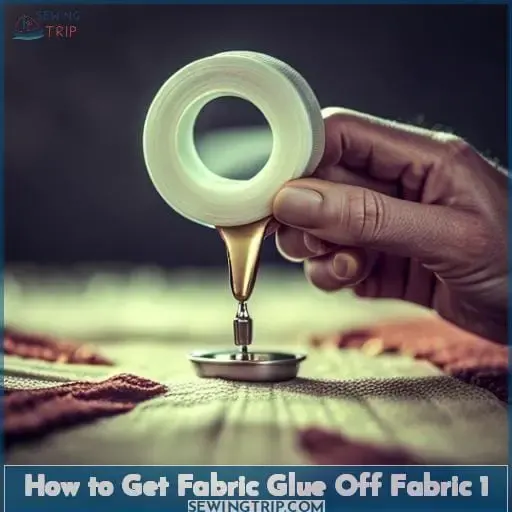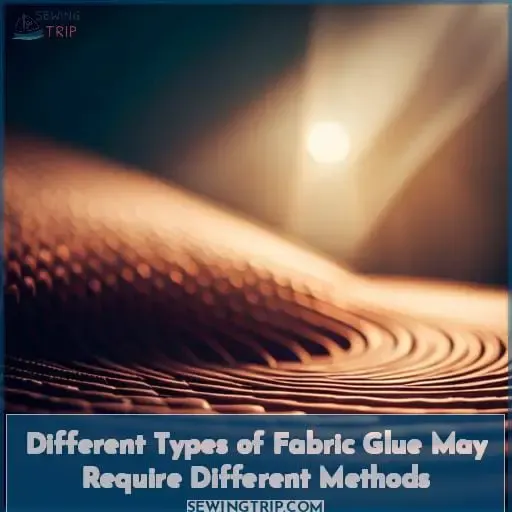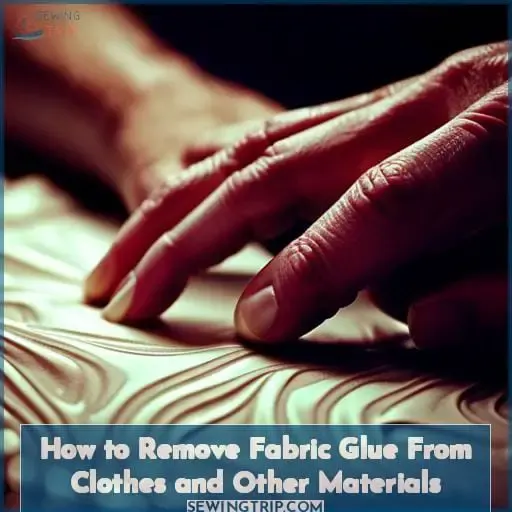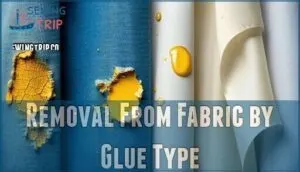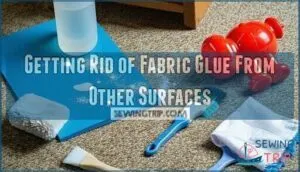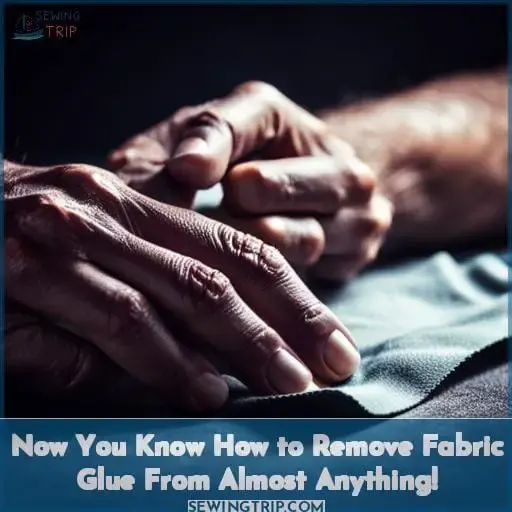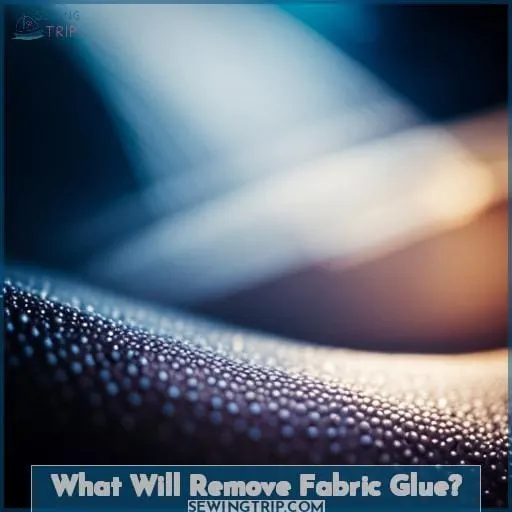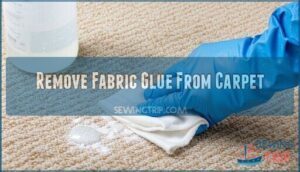This site is supported by our readers. We may earn a commission, at no cost to you, if you purchase through links.
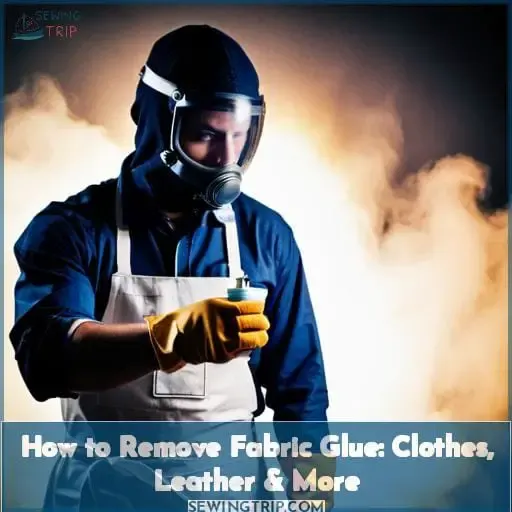 As you attempt to get fabric glue off fabric, it can feel like a daunting task. But don’t despair! With the right knowledge and some patience, you’ll be able to remove any unwanted adhesive residue without damaging your clothes or other fabrics.
As you attempt to get fabric glue off fabric, it can feel like a daunting task. But don’t despair! With the right knowledge and some patience, you’ll be able to remove any unwanted adhesive residue without damaging your clothes or other fabrics.
You’ll be surprised at how simple it is if you know the tricks of the trade when removing different types of fabric glue from various materials.
Table Of Contents
- Key Takeaways
- What is Fabric Glue?
- Different Types of Fabric Glue May Require Different Methods
- How to Remove Fabric Glue From Clothes and Other Materials
- How to Remove Fabric Glue From Certain Materials
- Removal From Fabric by Glue Type
- Getting Rid of Fabric Glue From Other Surfaces
- Now You Know How to Remove Fabric Glue From Almost Anything!
- Can You Remove Fabric Glue From Clothing?
- What Will Remove Fabric Glue?
- Remove Fabric Glue From Carpet
- Frequently Asked Questions (FAQs)
- Conclusion
Key Takeaways
- Different forms of fabric glue require different removal methods depending on the type of fabric and adhesive.
- Heat methods should be avoided for heat-sensitive synthetic fibers like polyester and silk.
- Soaking in cold water and washing at a high temperature can effectively remove fabric glue from most fabric types.
- Vinegar solutions and acetone are commonly used to break down the bond of fabric glue, but testing is important on delicate fabrics.
What is Fabric Glue?
Fabric glue is a useful tool when working with fabrics, especially for tasks such as hemming or mending. It comes in several forms: permanent fabric glue, temporary fabric glue, fabric glue tape, and waterproof and hot glues – each suited to different types of projects.
Permanent Fabric Glue
Removing permanent fabric glue from garments can be tricky. Knowing the type of fabric and glue is important before attempting removal. Here’s what to consider: Permanent bonding requires heat methods or a vinegar solution. Super Glue, Krazy Glue, and Fabric Tape require equal parts of fabric softener with a very hot iron. Acetone nail polish remover works on some fabrics but should be tested in an inconspicuous area first. Take caution when using strong solvents as proper ventilation and protective gloves are needed for safety.
Temporary Fabric Glue
Temporary fabric glue can be quickly removed with a few simple steps. Soak the affected area in cold water and scrub lightly with laundry detergent. This should do the trick. To remove temporary glue from polyester, use a cotton ball soaked in warm water to dab away at it.
For denim jeans or nylon materials, put them on a warm water wash cycle and add some fabric softener for extra cleaning power. Different types of fabrics require different removal methods depending on the type of glue used.
Make sure you know what kind of material your garment is made out of before beginning any removal process! With careful consideration for each unique situation, removing temporary fabric glue doesn’t have to be difficult.
Fabric Glue Tape
Fabric glue tape provides a semi-permanent hold, so you’ll likely need to take extra care when removing it. Pasting fabric together with cutting tape for different colors or types of fabrics requires adhesive options that are compatible and won’t leave behind stains.
Be careful when using acetone nail polish remover as it can damage some fabrics; instead, use the right type of fabric glue for waterproofing needs or other projects. Different types of glue require different removal methods. Heat loosens some, while others may require detergent solutions or scraping techniques.
Waterproof Fabric Glue
Waterproof fabric glue is ideal for projects that require a strong, long-lasting bond, but it can be tricky to remove if mistakes are made. Acetone works well in some cases; however, heat should be avoided with polyester fabrics.
An effective way to tackle tough stains from waterproof fabric glue is by using a cold water soak or dry cleaning chemicals. Along with that, scraping the material off manually before applying an iron’s heat or virgin olive oil can also be helpful.
Hot Glue
Hot glue is often used for quick fixes, but it can be tricky to remove if not done right. Hot glue is used for crafts and repairs on non-porous surfaces like plastic or metal. Safety should always be taken into account when using hot glue. Alternatives such as fabric tape are a good option for some projects.
Removal of hot glue requires caution. Acetone may work, though heat methods should generally be avoided with polyester fabrics.
Different Types of Fabric Glue May Require Different Methods
When working with fabric, it’s important to know which type of fabric glue is best suited for the job. Different kinds of fabric glue may require different methods for removal if mistakes are made or spills occur.
Heat methods such as ironing and steaming can be used on some types, but they should be avoided when dealing with synthetic fibers that could melt under high temperatures. Dry cleaning is a better option in this situation since it uses chemicals instead of heat to break down the bond between the fabrics and adhesive material.
Freezing also works well in loosening most adhesives from fabrics while detergent solutions combined with cold water can help remove other types such as hot glues or waterproof glues from cotton, denim, canvas, or nylon materials without damaging them too much during the process.
Scraping is another method that helps get rid of extra residue left behind by certain adhesives. However, acetone nail polish remover should only be used on these items after being tested first due to its chemical properties which might damage delicate fabrics like chiffon unless specially formulated superglue removers are used instead.
This should be followed by a thorough washing afterwards using an appropriate laundry detergent solution along with either rubbing alcohol (isopropyl) or vinegar depending upon what kind of sticking substance remains after all else has failed.
In short, no matter what type you use — permanent versus temporary — it pays to familiarize yourself beforehand so you’ll know how best to proceed if something goes wrong resulting in needing to achieve success at removing stubbornly stuck-on remnants before any further progress can resume!
How to Remove Fabric Glue From Clothes and Other Materials
Removing fabric glue from clothes and other materials doesn’t have to be a hassle. You can use an iron, another form of steamed heat, dry cleaning for certain adhesives, or even soak in cold water before washing it on high heat.
Remove Fabric Glue With an Iron
Ironing can be a great way to quickly and easily remove fabric glue from your clothes! Adjust the heat setting on your iron according to the type of fabric you’re working with. Steaming techniques will also work if it’s not safe for the material in question.
Dry cleaning methods, which use chemicals instead of heat, are another option. For stubborn adhesives, cold water soaking followed by high heat washing may be necessary. When dealing with smaller areas, you can use a warm water solution combined with a Q-tip.
To break up residue left behind after scraping, you can use food-grade vinegar or acetone nail polish remover.
Use Another Form of Steamed Heat
You can also use steamed heat to loosen fabric glue, making it easier to remove without damaging your clothes. Using heat, freezing, dry cleaning, and acetone are all effective methods for removing fabric glue.
Rubbing alcohol is often used in tricky spots or hard-to-reach areas. Washing machines make the job easier, with a paper towel stuck inside as the best method for clothes that could be damaged by acetone or other chemical solutions.
To ensure success when using any of these methods on fabric glue, always test an inconspicuous area first.
Dry Cleaning Can Remove Certain Adhesives
Dry cleaning can help break the bond of certain adhesives, allowing you to easily remove them without damaging delicate fabrics. Alternatives like heat removal and acetone are not always suitable for some fabrics, which is why dry cleaning may be a better option.
It has benefits such as being able to deal with super glue. Another alternative is vinegar instead of acetone. If using this method, it’s important to use a clean cloth when wiping away dried glue from fabric and take it into local dry cleaners who specialize in removing adhesive residue safely and effectively if needed.
Soak in Cold Water
Soaking in cold water can be an effective way to break down some fabric glue bonds. Adding a small amount of vinegar to the soak may help, but scraping residue with a dull knife might also do the trick.
It’s important to note that heat methods and acetone removal should not be used on delicate fabrics. However, soaking in cold water is a great alternative option for those materials. Dry cleaning is also a viable method for many different kinds of fabrics and glues.
There are several reasons why this method is popular. It’s easy to do and doesn’t require any harsh chemicals or tools that could damage clothing fibers.
Wash on a High Heat
Wash away fabric glue with a high heat cycle, like an iron melting stubborn grime. For fabrics that are more heat sensitive, such as chiffon or synthetic fibers, vinegar-based removers can help loosen super glue bonds and dissolve wallpaper glues.
Use a simple soda paste of baking soda and coconut oil to remove strong fabric adhesive. Alternatively, try spraying the area with white glue, followed by wiping off excess residue with soap and water for easy removal.
One of the most effective ways to lift even tough glues without damaging delicate materials is Jess Faraday’s method. It involves spraying cold water on the affected area and then using steam from an iron.
How to Remove Fabric Glue From Certain Materials
Removing fabric glue from different materials can be a challenge, but with the right techniques, you’ll have your fabrics looking like new again. It’s important to know the type of material and adhesive before starting any removal attempts as methods vary depending on what you’re working with.
From silk and polyester to cotton, leather, and woolens, we’ll cover how to remove fabric glue from all these different materials in this discussion.
How to Remove Fabric Glue From Silk
For silk fabrics, acetone or isopropyl alcohol are effective removal methods—just be sure to take proper safety precautions and test a small inconspicuous area first. Vinegar and cold water can also work if the glue isn’t too thick. Commercial super glue removers are good for chiffon, while thinned fabric glue can often be removed with old-school methods like steamed heat or dry cleaning.
How to Get Rid of Adhesive From Polyester
Removing adhesive from polyester is no small feat! To tackle this tricky task, you’ll need to use acetone or isopropyl alcohol for the best results.
A good way to remove the glue is by soaking in equal parts cold water and vinegar. Then, dab with acetone. Another option is to mix baking soda paste with coconut oil, which can also help get rid of stubborn adhesive.
If all else fails, you can try rubbing alcohol on hard surfaces. However, keep in mind that this method takes a long time. If needed, you can mix two-thirds of a bottle of rubbing alcohol with one part vinegar.
How to Shift Fabric Glue From Cotton
To successfully shift fabric glue from cotton, you may need to try a range of strategies. From soaking the material in a cold water and vinegar solution to dabbing with acetone or mixing up baking soda paste with coconut oil.
For stubborn adhesive residue, use a credit card to scrape off excess glue under even pressure. If that fails, try fabric softener for an easier method. But be sure not to leave it on for too long as it can cause discoloration! As an alternative simple approach when all else fails, use super glue remover on chiffon fabrics.
How to Wipe Glues From Leather
Wipe away frustrating fabric glue from leather with an effective yet gentle technique – use a vinegar and water solution for a crafty clean-up. To remove glues properly, knowledge of adhesive types is key. Heat methods can loosen some, but be careful as it may damage the material.
Cleaning solutions such as detergent or baking soda paste are also useful. Commercial removers should be used when necessary. Be aware that extra glue in the wrong place can cause problems too! Simple ways to separate adhesives include using acetone and scraping off any excess residue before it hardens.
How to Lift Glue Stains From Woolens
Lift stubborn fabric glue stains from woolens with a water and ammonia solution. Freezing techniques, steamed heat, or commercial removers can be used to remove adhesive mistakes. It’s important to consider the easiest ways of removal as well as other important aspects like the latest information on best practices.
Removal From Fabric by Glue Type
Are you looking for ways to remove fabric glue from clothing? From Gorilla Glue to Hem Tape Adhesive, Super Glue, and Elmer’s Glue, it can be tricky to get the adhesive off your fabrics without damaging them.
In this discussion, we’ll cover how to best lift Gorilla Glue from clothing, remove hem tape adhesive from fabric, get superglues off clothes, as well as Elmer’s glue, and finally, how to clean eyelash glues from garments.
How to Lift Gorilla Glue From Clothing
You can tackle Gorilla Glue on clothing by utilizing a variety of methods, depending on the fabric type. For removing glue from synthetic fibers like polyester or silk, it’s a good idea to avoid heat and instead opt for freezing or dry cleaning.
When it comes to cotton, denim, and nylon fabrics, you can use detergent-based solutions with water as well as scraping techniques with acetone. Woolens may require ammonia in addition to water when it comes time for glue removal.
Super glue should be attacked using baking soda paste applied throughout the entire area where possible.
No matter what type of adhesive you’re dealing with – gorilla glue included – always remember that each fabric requires its own tailor-made approach for successful results!
How to Remove Hem Tape Adhesive From Fabric
Gently scrub away the adhesive of your hem tape for a clean fabric finish. There are numerous methods to get rid of the glue residue, depending on what type it is: permanent, temporary, or even super glue.
The first way to tackle these adhesives would be with a fabric softener and water solution. Follow this by scraping off any remaining pieces with peanut butter. If that doesn’t work, you could try commercial-grade super glue remover or other solvent-based products like acetone and rubbing alcohol.
With patience and some elbow grease, how to get fabric glue off fabric should not be too difficult after all!
How to Get Super Glue Off of Clothes
Removing super glue from clothes can be tricky, but with the right methods, it’s possible. Heat methods, such as an iron or steamer, should never be used on heat-sensitive synthetic fibers. Soaking the clothes in cold water and washing them on a high temperature is effective for most fabric types.
Vinegar solutions work well to break down the bond of super glue. Another option is using acetone remover, but caution must be taken when using harsh chemicals near fabrics.
How to Remove Elmer’s Glue From Material
Forget the fabric glue fiasco – Elmer’s is here to help you learn how to make your material mess-free! Heat removal methods should be avoided on heat-sensitive synthetic fibers, but soaking in cold water and washing at a high temperature usually does the trick.
Baking soda paste or a commercial remover can also remove stubborn Elmer’s Glue from fabric. For tough spots, use vinegar solutions and acetone as last resort options with proper ventilation and gloves for safety.
How to Clean Eyelash Glue From Your Garments
Don’t let eyelash glue ruin your favorite garment – make sure to use the right techniques for effectively removing it! Instead of relying solely on this adhesive, consider using alternatives like lash strips or magnetic lashes.
Soaking in warm water with laundry detergent and rubbing alcohol are great methods that won’t cause an allergic reaction or damage the fabric. For stubborn residue, use vinegar solutions and acetone as last resort options; proper ventilation is necessary for both products.
Reuse your lashes if you can – just follow these tips next time when cleaning up any adhesive!
Getting Rid of Fabric Glue From Other Surfaces
Are you looking for ways to remove fabric glue from surfaces such as plastic, carpet, glass, or wood? Or perhaps even from your skin? With the right technique and knowledge, it can be done without causing any damage.
In this discussion, we will cover how to clean fabric glue off various surface areas, including plastic, carpeting, and glass windows. We will also provide guidance on getting rid of adhesive on wood items and safely removing any residue that may have come into contact with your skin.
How to Clean Fabric Glue Off of Plastic
Cleaning fabric glue off of plastic surfaces can be like trying to peel a banana with one hand – sometimes it’s just easier said than done.
Removing Glue – Fabric Softener, Acetone, Baking Soda & Coconut Oil.
Wet fabric softener or coconut oil on the adhesive and let it sit for several minutes before scrubbing away with a cloth or paper towel. For tougher glues, try acetone or baking soda paste mixed with water for an abrasive cleaning solution that won’t damage plastics.
Whatever method you choose, make sure to take care not to scratch your surfaces!
How to Lift Fabric Glue Off of Carpet
Removing fabric glue from carpet can be a challenge, but with the right tools and techniques, you’ll soon have your carpets looking good as new! Cleaning solutions like vinegar or acetone remover should do the trick.
Heat methods are also effective for loosening up stubborn adhesive. Scraping techniques using plastic utensils may help remove excess residue afterward.
How to Shift Fabric Adhesive From Glass
Shifting fabric adhesive from glass requires the right approach – try gently prying it away with a plastic utensil and some elbow grease! For more stubborn glue, heat can help loosen its grip.
Remove any excess residue with one of these steps:
- Use acetone remover for hot or super glue.
- Soak fabric tape in warm water.
- Rubbing alcohol works on most adhesive types.
But beware–acetone is powerful stuff, so take care to use protective gloves and ensure proper ventilation when using this method.
With patience and finesse, you can free yourself from sticky situations without causing damage to the surface beneath.
How to Get Fabric Glue Off of Wood
Gently tugging at the dried fabric adhesive can help you lift it off wood surfaces, but be sure to use appropriate methods for different glue types and fabrics. For hot or super glue, try acetone remover; fabric tape is best soaked in warm water; and rubbing alcohol works on most adhesives.
Vinegar solutions are great for sticker residue, while commercial removers tackle chiffon-based glues. When using acetone, always wear protective gloves with proper ventilation—and bear in mind that different fabrics require unique techniques! With patience and finesse, liberate yourself from sticky situations without damaging the surface beneath.
How to Clean Fabric Glues Off of Your Skin
No matter what type of fabric glue you encounter, swiftly cleaning it off your skin is essential.
Be mindful of potential allergies or skin sensitivity when using chemical removers. Always take protective measures such as gloves and ventilation when dealing with harsh chemicals like acetone or rubbing alcohol.
For milder remedies, consider baking soda mixed with coconut oil paste or vinegar solutions for sticker residue.
Liberate yourself from sticky situations quickly and safely – no more lingering glues on your hands!
Now You Know How to Remove Fabric Glue From Almost Anything!
You’ve mastered the art of fabric glue removal! Now you can feel confident tackling any sticky situation that comes your way. With knowledge and experience in different types of fabrics, glue varieties, and various methods to remove them effectively without damage or risk – you are well equipped for success.
Here’s a quick summary of what you need to know:
- Cleaning tips: Different surfaces require different techniques for cleaning off fabric glue residue. For example, ironing on low heat or scraping with a plastic knife.
- Fabric types: Polyester fibers should avoid heat-based methods, while cotton, denim, canvas, and nylon may benefit from detergent/water solutions, freezing techniques, or acetone application. Woolens may require a water and ammonia solution, whereas chiffon requires specific superglue remover products.
- Glue varieties: Permanent glues will be difficult to remove, so it’s best to use temporary adhesives when possible. However, if permanent glue is used, then soaking in cold water or washing on high heat is the most effective method, along with using a laundry detergent and fabric softener paste made up of baking soda and coconut oil, etc.
- Removal Methods / Safety Precautions: Heat can loosen some types of glues (iron steamed), dry cleaning is suitable for synthetic fibers and sensitive materials like chiffon. Vinegar can be used to remove sticker residue, and baking soda can break the bond of superglue. Tape can provide a semi-permanent bond. Caution must be taken when dealing with acetone or nail polish remover on certain fabrics. Test in an inconspicuous area first and always make sure proper ventilation and protection gloves are available in case rubbing alcohol is being used.
Now that all these components have been discussed and understood, you’re ready to tackle those sticky situations head-on! Whether it’s mistakes, spills, contamination, or any other reason, let nothing stand between the liberating power and mastery over removing stubborn adhesive confidently and assuredly, no matter the surface material involved.
Can You Remove Fabric Glue From Clothing?
Now that you know how to remove fabric glue from almost anything, let’s take a look at the specific steps needed for removing it from clothing.
To start, determine what type of fabric is involved and what type of glue was used – permanent or temporary adhesives require different removal methods.
| Fabric | Removal Method | Notes |
|---|---|---|
| Polyester | Freezing/Boiling/Dry Cleaning/Acetone/Isopropyl Alcohol | Laundry Detergent&Water Solutions |
| Cotton, Denim, Canvas & Nylon | Detergents & Water solutions | Acetone |
| Woolens | Ammonia Solution | |
| Chiffon | Super Glue Remover |
Trying to use heat-based methods on polyester fibers should be avoided as much as possible due to their sensitivity. For cotton, denim, canvas, and nylon fabrics, detergent water solutions are an effective way for removing adhesive residue without damaging the garment, while acetone can also prove useful in these cases.
Woolen garments may need a special ammonia solution, whereas chiffon requires its own superglue remover product when dealing with stubborn adhesive residues.
As far as general safety precautions go, make sure there is adequate ventilation when using any chemical solvents such as acetone nail polish removers or rubbing alcohols. Vinegar can be helpful in sticker residue removal, baking soda breaks down bonds created by some types of superglues, while tape provides semi-permanent bonding.
What Will Remove Fabric Glue?
Are you looking for an effective way to remove fabric glue from your clothes? You can use a variety of methods depending on the type of fabric and adhesive used, such as ironing, using fabric softener, or removing with various solutions like acetone.
For example, polyester is sensitive to heat, so it should be treated with freezing or boiling water rather than an iron. On denim jeans and other cotton materials, detergents mixed with water are usually enough, while nylon needs an acetone solution for removal.
Chiffon may require special superglue remover products, whereas woolen fabrics need ammonia solutions.
Remove Fabric Glue With Iron
Take the heat up a notch and remove fabric glue with an iron! Set the temperature low to avoid damaging delicate fabrics, then use steam or dry cleaning solvent solutions for stubborn adhesive. Iron gently over the area until the residue is removed; if it persists, try an adhesive remover.
Remove Glue With Fabric Softener
Soak the affected area in fabric softener and water for several minutes to help loosen the grip of the glue. Use heat methods, a vinegar solution, or acetone remover on waterproof glues. Super glue may require a baking soda paste or a commercial super glue remover.
Remember to use proper ventilation and wear protective gloves when using solvents! To achieve the best results, test an inconspicuous area first to check for colorfastness.
How to Remove Fabric Glue From Polyester
Avoid heat methods to remove fabric glue from polyester fabrics, as they can damage them. Cold water soaking and acetone use are effective solutions for removing the adhesive. For super glue, try a baking soda paste or commercial remover instead. Always test an inconspicuous area first before using any method! Pay attention to ventilation when working with acetone or other solvents and wear protective gloves while handling them too.
How to Get Fabric Glue Off Denim or Jeans
To remove fabric glue from denim or jeans, try a combination of detergent and water solutions, freezing, scraping, and acetone. Hot glue can be scraped away when frozen, while superglue requires a baking soda paste or commercial remover.
Fabric softener helps with stubborn spots, but use caution when using acetone – test an inconspicuous area first! Proper ventilation is key, as well as protective gloves for safe removal.
How to Remove Fabric Glue From Nylon
Try removing fabric glue from nylon fabrics with detergent and water solutions, freezing, scraping, or acetone. Cleaning glue from nylon may require heat treatments such as boiling or freezing to loosen the bond of the adhesive.
Use a commercial superglue remover for stubborn spots; use fabric softener if needed. Take caution when using acetone: test an inconspicuous area first and ensure proper ventilation with protective gloves.
From Cotton
Removing fabric glue from cotton, denim, canvas, or nylon fabrics may require detergent and water solutions, freezing, scraping, or acetone. Have you ever wondered how to get rid of stubborn adhesive without damaging the fabric? Vinegar can be used for removing residue; baking soda mixed with coconut oil makes a powerful paste solution.
From Chiffon
For chiffon fabrics, removing superglue can be tricky. Try using a commercial superglue remover and remember to test it first on an inconspicuous area. Avoid using heat methods on this delicate fabric; instead, use vinegar or other solvent-based removers.
If there is stubborn glue residue, a combination of baking soda paste and coconut oil may be effective.
From Wool
To remove fabric glue from woolens, use a water and ammonia solution for optimal results. For tougher stains, freezing techniques can be effective; alternatively, scraping with an appropriate tool may help remove the adhesive.
Avoid using acetone when removing this type of glue from delicate fabrics like woolen garments as it can damage or discolor them. Try other solutions such as vinegar or rubbing alcohol to achieve the desired outcome without any alteration in the quality of the material used.
Remove Fabric Glue From Carpet
You can tackle fabric glue on carpets with a variety of removal methods, depending on the type of adhesive and carpet fibers.
- Heat methods such as using an iron or steamed heat to loosen some types of glue.
- Dry cleaning is best used for heat-sensitive synthetic fibers like polyester.
- Soaking in cold water and washing on high heat may help remove certain fabrics from the carpet.
- Commercial removers are available to treat tougher areas that cannot be reached by other solutions.
- Vinegar solutions are great for sticky residue left behind by stickers or labels.
When choosing what method will work best, it is important to consider which type of adhesive was used as well as the material your carpet is made from. For instance, acetone nail polish remover should always be tested in an inconspicuous area before use since it could damage more delicate fabrics like chiffon if overused.
Also, keep in mind that proper ventilation and protective gloves must be worn when working with harsh chemicals such as rubbing alcohol or acetone.
The most effective way to get rid of any unwanted fabric glue stain without causing damage will depend upon both these factors combined! With careful consideration, you’ll have no problem finding a suitable solution – giving your carpets back their original look while leaving them free from stubborn stains!
Frequently Asked Questions (FAQs)
How do I know which type of fabric glue to use?
Not sure which fabric glue to use? Look no further! With a variety of options, you’ll be able to find the perfect option for your project with ease.
What are the best methods for removing fabric glue from delicate fabrics?
When removing fabric glue from delicate fabrics, it’s important to know the type of glue and fabric. Use freezing or boiling water for synthetic fibers, detergent and water solutions for cotton, denim, and nylon.
For woolens, try a mixture of ammonia and water, while chiffon may need a commercial remover.
What are some alternatives to using fabric glue?
Discover the endless possibilities of staples, snaps, buttons, and pins! They provide a secure bond that won’t leave your fabric stained or damaged. With these alternatives to fabric glue, you can confidently create whatever project you desire without worrying about it coming undone or having difficulty removing it later.
What safety precautions should I take when using fabric glue?
When using fabric glue, always wear protective gloves and ensure proper ventilation. Avoid using heat methods on sensitive fabrics and test acetone nail polish remover in an inconspicuous area first. Steer clear of super glues when working with delicate materials like chiffon – use a commercial remover instead.
How do I store fabric glue to ensure it does not dry out?
Store fabric glue in an airtight container to prevent it from drying out. When tightly sealed, it will last longer and remain effective when needed.
Conclusion
The takeaway here is that fabric glue can be a tricky substance to remove, but with the right knowledge and tools, it can be done. Whether you’re dealing with permanent, temporary, fabric glue tape, waterproof, hot glue, or super glue, there is a removal method suitable for each type and fabric.
You’ll need to keep in mind that any removal method can be daunting and time-consuming, but with a bit of perseverance and patience, you can conquer it in no time.

